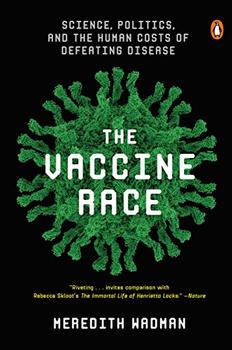Summary | Excerpt | Reviews | Beyond the Book | Readalikes | Genres & Themes | Author Bio

Critics' Opinion:
Readers' Opinion:
First Published:
Feb 2017, 448 pages
Paperback:
Sep 2018, 464 pages
 Book Reviewed by:
Book Reviewed by:
Zoë Fairtlough
Buy This Book
Then in the summer of 1961, Americans learned that the monkey kidney cells used to make the famous Salk polio vaccine harbored a monkey virus called SV40. Tens of millions of American children had already received contaminated injections, and while the jury was still out on the tainted vaccine's long term health consequences, the unknown risks were weighing on regulators in the United States and elsewhere.
It was against this backdrop that, on a drizzly June morning in 1962, a young scientist went to work in his lab at the Wistar Institute of Anatomy and Biology, an elegant 1890s brownstone tucked in the heart of the University of Pennsylvania campus. Leonard Hayflick had just turned thirty four years old. A serious, slight reserved man with close cropped dark hair, Hayflick was a product of working class Philadelphia and was hungry to make his name. He was in love with biology and was plenty smart, he had come to believe—but that fact was far from appreciated. His boss, the famous polio vaccine pioneer Hilary Koprowski, saw him as a mere technician, hired to serve up bottles of lab grown cells to the institute's impressive cadre of biologists.
This hadn't deterred the ambitious Hayflick. The previous year the junior scientist had published a paper challenging a major piece of scientific dogma: the belief that cells grown in a lab bottle, if properly nurtured, would multiply forever. His findings had been met with skepticism from some outstanding biologists. Let the critics carp, he thought. Time would prove that he was right—that normal cells cultivated in the lab eventually died, just like human beings.
On this drizzly day, however, Hayflick's mind was not on cell death but on cell birth. Today, he hoped, he was going to launch a group of normal human cells that would revolutionize vaccine making. He had been waiting months for this opportunity—waiting for the arrival of the lungs that would be the source of these new cells. Cells were needed to make antiviral vaccines because outside of cells viruses can't multiply. And huge quantities of virus were needed to produce vaccines. Now, at last, the lungs were here in his bustling second floor lab, two purplish things floating in clear pink fluid in a glass bottle. They had traveled all the way from Sweden packed on wet ice, courtesy of a Koprowski colleague who was a top virologist at the prestigious Karolinska Institute in Stockholm.
Several days earlier a woman living near Stockholm had had an abortion. Most Swedish physicians frowned upon the procedure, but it was legal, even for not strictly medical reasons. The woman was sixteen or seventeen weeks pregnant and had several children already. Her husband, she told her doctors, was an unsupportive alcoholic. The decision was clear. She sought out a sympathetic gynecologist, Eva Ernholm, one of the rare women in Swedish medical ranks, to perform the procedure.
After the abortion the eight inch long, female fetus was wrapped in a sterile green cloth and delivered to a yellow brick outbuilding on the grounds of the National Biological Laboratory in northwest Stockholm. Here, in what they nicknamed the "monkey house" because it was also home to monkeys used in making polio vaccine, young PhD and medical students were occasionally called on to dissect out the lungs of aborted fetuses for shipping to the Wistar Institute. It wasn't a pleasant task, but when their boss, Sven Gard, the top virologist at the Karolinska Institute, asked them to do it, they obliged, slipping on head covers and changing from white wooden clogs to red or blue ones when they entered the sterile rooms. Other employees, working nearby in a grand building with a spiral staircase, were responsible for packing the lungs on ice and transporting them to Bromma Airport for the transatlantic flight that would eventually bring them to Philadelphia.
Hayflick was convinced that compared with monkey kidney cells, which were often laden with lurking viruses, normal human cells would serve as cleaner, safer vehicles for making antiviral vaccines. And he knew that he was uniquely positioned to produce a long lasting supply of such cells. He had spent the previous three years perfecting the procedure that would do it.
Excerpted from The Vaccine Race by Meredith Wadman. Copyright © 2017 by Meredith Wadman. Excerpted by permission of Viking. All rights reserved. No part of this excerpt may be reproduced or reprinted without permission in writing from the publisher.





The Flower Sisters
by Michelle Collins Anderson
From the new Fannie Flagg of the Ozarks, a richly-woven story of family, forgiveness, and reinvention.

The House on Biscayne Bay
by Chanel Cleeton
As death stalks a gothic mansion in Miami, the lives of two women intertwine as the past and present collide.

The Funeral Cryer by Wenyan Lu
Debut novelist Wenyan Lu brings us this witty yet profound story about one woman's midlife reawakening in contemporary rural China.
Your guide toexceptional books
BookBrowse seeks out and recommends the best in contemporary fiction and nonfiction—books that not only engage and entertain but also deepen our understanding of ourselves and the world around us.